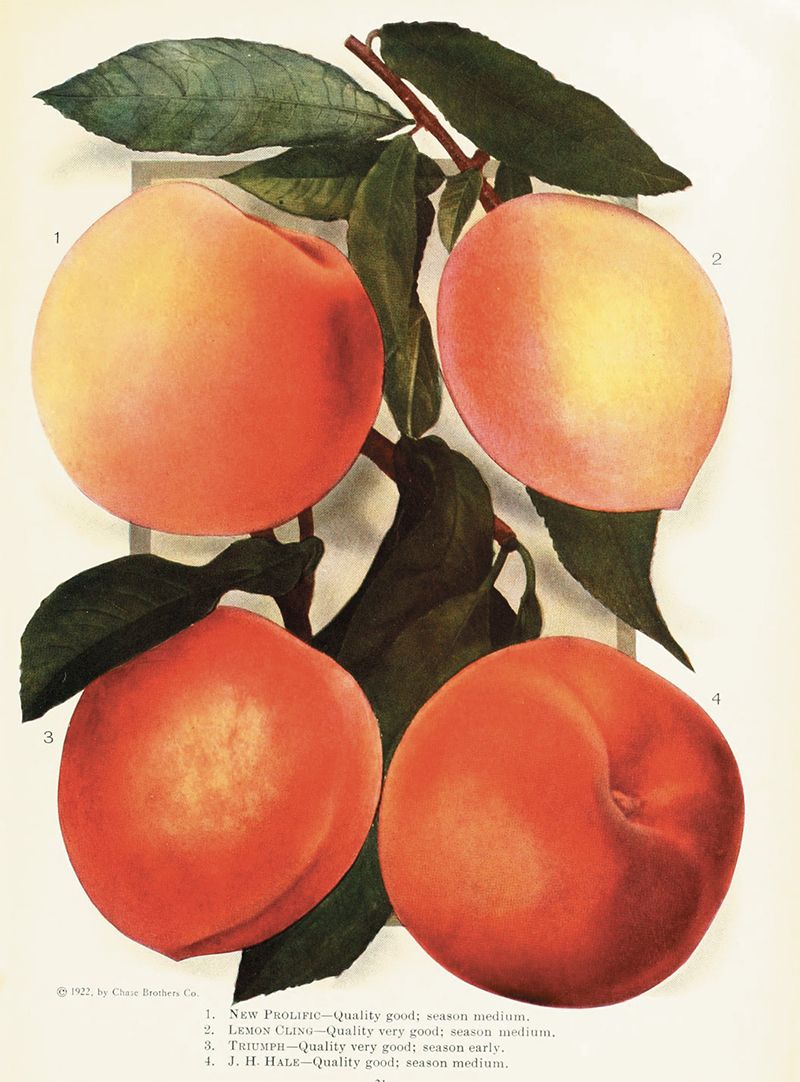In the mid-18th century, one vibrant yellow peach was the most popular in the land

Peachy Keen: Similar to its namesake fruit, the lemon cling (top right) has an oblong shape and yellow flesh; however, it’s known for its sweetness.
While it doesn’t own the moniker “The Peach State,” South Carolina grows more tons of the stone fruit per year—about 60,000—than Georgia and has done so for decades. Today, the bulk of our state’s fruit comes from the Piedmont, but Charleston has its own distinctive peach history.
Here, in the mid-18th century, botanist and seed broker Martha Logan maintained a garden and nursery on Trott’s Point (a tract of land on the east side of the peninsula, cornered off by King and Hassel streets) that contained peaches, nectarines, and apricots, which she sold to area residents. These stone fruits had to be imported (Logan ordered her seed stock from England), for only a small variety of native fruit grew here at the time: paw paw, shadbush, persimmon, mayhaw, sand plum, and wild black cherry. Peaches, in fact, originated in China, and Spanish settlers brought them to the Western Hemisphere.
Sometime prior to the Revolutionary War, Logan received a vibrant yellow-fleshed peach of robust growth and luscious texture. Called the “lemon peach” or “lemon cling” (short for “clingstone,” the type of stone fruit whose flesh “clings” to the pit), it would soon spread to orchards across the country and be immortalized in a brandy-infused dessert. In South Carolina’s first cookbook, The Carolina Receipt Book: or, Housekeeper’s Assistant, by A Lady of Charleston (1832), “Peaches in Brandy” were made by simmering the fruit with sugar and the booze over the stovetop. Compared to other varieties, the lemon cling was “the most juicy and highest flavoured of all the Clingstone peaches” and stood up the best to brandy, according to Declaration of Independence writer Timothy Matlack, who sampled the fruit at Thomas Jefferson’s Monticello and whose description appears in The Fruit and Fruit Trees of Monticello.
The peach Matlack was referring to was likely “Kennedy’s Carolina,” a variety named after Robert Kennedy, a New Yorker who visited Charleston in 1788 and brought one of Logan’s peaches from the Holy City up North. In New York, Kennedy enlisted pomologist William Prince, the greatest nurseryman of the day, in propagating the lemon cling at his Flushing Landing nursery. Soon after the Civil War, the canning industry seized it, and for about half a century, lemon clings were the most popular canned peach in the country.
Meanwhile, here in its hometown, the fruit had not been grown since the 1880s. Charleston’s chief nursery, Geraty Seeds in Yonges Island, offered 35 peach varieties in 1907, but the lemon cling was absent from the list. However, in December 2017, the Holy City’s chapter of Slow Food started an effort to fund the restoration of the lemon cling, underwriting the creation of a grove on John’s Island maintained by Geechie Boy Mill’s Greg Johnsman. With seed stock and guidance from horticulturists at Monticello (one of the only sites in the United States that grows lemon clings today), the Lowcountry’s prized fruit will soon be available again.
Image from Chase Fruit & Flowers catalog (1922)